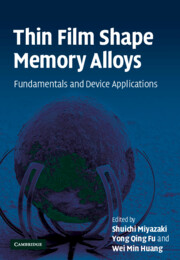Book contents
- Frontmatter
- Contents
- List of contributors
- Preface
- Abstracts of chapters
- 1 Overview of sputter-deposited TiNi based thin films
- 2 Martensitic transformation in TiNi alloys
- 3 Deposition techniques for TiNi thin film
- 4 TiNi multilayer thin films
- 5 Crystallization and microstructural development
- 6 Mechanical properties of TiNi thin films
- 7 Stress and surface morphology evolution
- 8 Ion implantation processing and associated irradiation effects
- 9 Laser post-annealing and theory
- 10 Overview of thin film shape memory alloy applications
- 11 Theory of SMA thin films for microactuators and micropumps
- 12 Binary and ternary alloy film diaphragm microactuators
- 13 TiNi thin film devices
- 14 Shape memory microvalves
- 15 Superelastic thin films and applications for medical devices
- 16 Fabrication and characterization of sputter-deposited TiNi superelastic microtubes
- 17 Thin film shape memory microcage for biological applications
- 18 Shape memory thin film composite microactuators
- 19 TiNi thin film shape memory alloys for optical sensing applications
- Index
1 - Overview of sputter-deposited TiNi based thin films
Published online by Cambridge University Press: 23 February 2010
- Frontmatter
- Contents
- List of contributors
- Preface
- Abstracts of chapters
- 1 Overview of sputter-deposited TiNi based thin films
- 2 Martensitic transformation in TiNi alloys
- 3 Deposition techniques for TiNi thin film
- 4 TiNi multilayer thin films
- 5 Crystallization and microstructural development
- 6 Mechanical properties of TiNi thin films
- 7 Stress and surface morphology evolution
- 8 Ion implantation processing and associated irradiation effects
- 9 Laser post-annealing and theory
- 10 Overview of thin film shape memory alloy applications
- 11 Theory of SMA thin films for microactuators and micropumps
- 12 Binary and ternary alloy film diaphragm microactuators
- 13 TiNi thin film devices
- 14 Shape memory microvalves
- 15 Superelastic thin films and applications for medical devices
- 16 Fabrication and characterization of sputter-deposited TiNi superelastic microtubes
- 17 Thin film shape memory microcage for biological applications
- 18 Shape memory thin film composite microactuators
- 19 TiNi thin film shape memory alloys for optical sensing applications
- Index
Summary
Abstract
The motivation for fabricating sputter-deposited TiNi base shape memory alloy (SMA) thin films originates from the great demand for the development of powerful microactuators, because actuation output (force and displacement) per unit volume of thin film SMA exceeds those of other microactuation mechanisms. Stable shape memory effect and superelasticity, which are equivalent to those of bulk alloys, have been achieved in sputter-deposited TiNi thin films. Narrow transformation temperature hysteresis and high transformation temperatures were also achieved in TiNiCu and TiNi (Pd or Hf) thin films, respectively. In the meantime, unique microstructures consisting of non-equilibrium compositions and nanoscale precipitates in the matrix have been found in Ti-rich TiNi thin films which were fabricated from an amorphous condition by annealing at a very low temperature. Several micromachining processes have been proposed to fabricate the prototypes of microactuators utilizing TiNi thin films. This chapter will review the recent development of the above-mentioned topics relating to sputter-deposited TiNi based thin films. Some critical issues and problems in the development of TiNi thin films are discussed, including preparation and characterization considerations, residual stress and adhesion, frequency improvement, fatigue and stability, and thermomechanical modeling. Recent development in the microdevices based on SMA thin films is also summarized.
Introduction
A shape memory alloy (SMA) is a metal that can “remember” its geometry, i.e., after a piece of SMA has been deformed from its original shape, it regains its original geometry by itself during heating (shape memory effect) or simply during unloading at a higher ambient temperature (superelasticity).
- Type
- Chapter
- Information
- Thin Film Shape Memory AlloysFundamentals and Device Applications, pp. 1 - 72Publisher: Cambridge University PressPrint publication year: 2009
- 2
- Cited by



